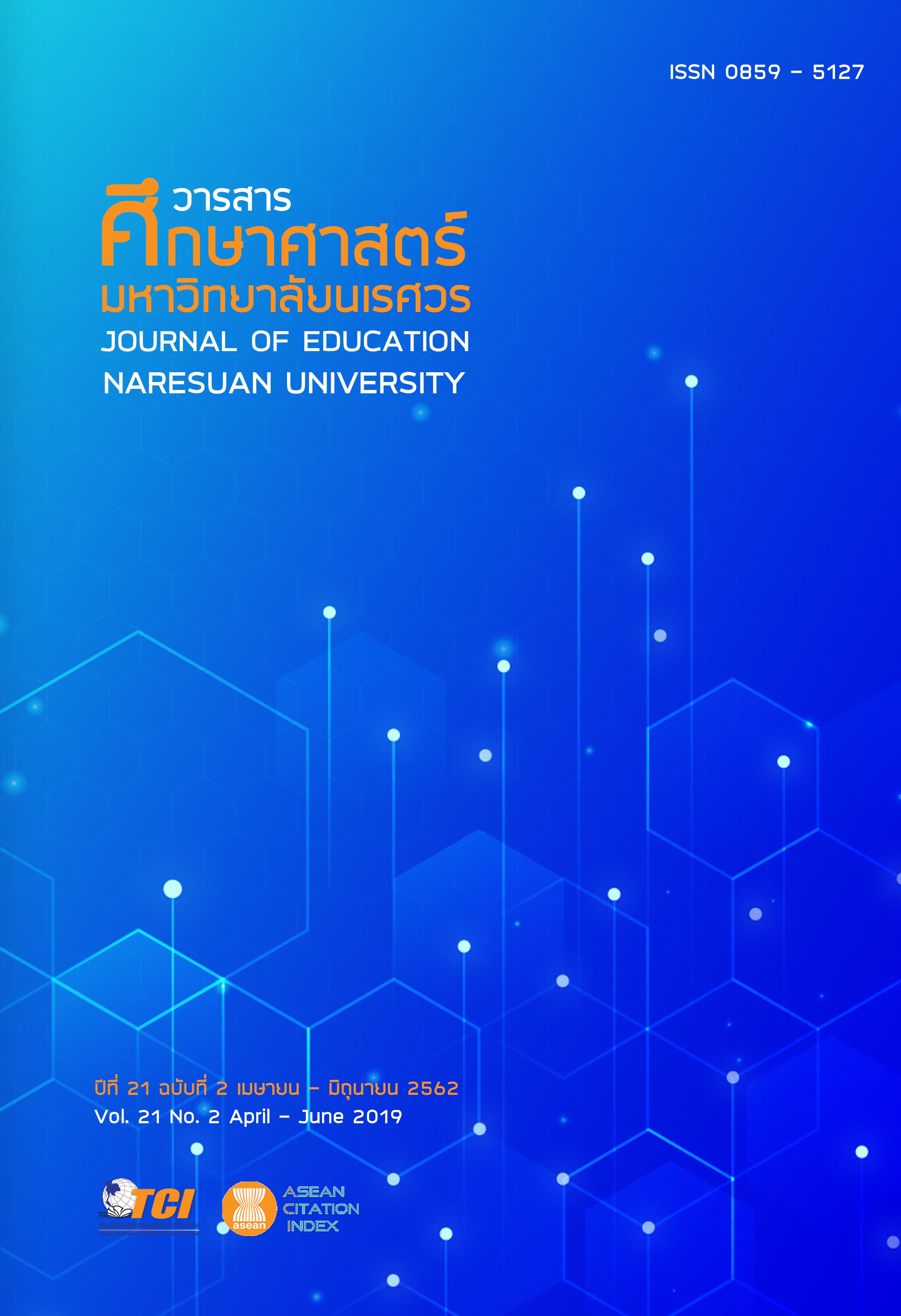การพัฒนารูปแบบการจัดการความรู้ของกลุ่มอาชีพผ้าทอมือจังหวัดเลย (THE DEVELOPMENT OF KNOWLEDGE MANAGEMENT MODEL OF HAND – WOVEN SILK CAREER GROUP IN LOEI)
Main Article Content
Abstract
การวิจัยนี้มีวัตถุประสงค์ 3 ประการ คือ 1) ศึกษาสภาพและปัญหาการจัดการความรู้ของกลุ่มอาชีพผ้าทอมือจังหวัดเลย 2) สร้างรูปแบบการจัดการความรู้ 3) ประเมินรูปแบบการจัดการความรู้ วิธีดำเนินการวิจัยในด้าน การศึกษาสภาพและปัญหาการจัดการความรู้ ข้อมูลได้จากการสัมภาษณ์ผู้ทรงคุณวุฒิด้านผ้าทอมือ จำนวน 11 คน การร่างรูปแบบการจัดการความรู้ จากข้อมูลในตอนแรกบูรณาการกับกรอบแนวคิดทฤษฎีการจัดการความรู้ของ Marquardt 6 ขั้นตอน และแนวคิดทฤษฎีการสร้างความรู้ของ Nonaka and Takeuchi จำนวน 4 ขั้นตอน ตรวจสอบโดยผู้ทรงคุณวุฒิ จำนวน 7 คน และการประเมินรูปแบบการจัดการความรู้ โดยการสัมมนาอิงผู้เชี่ยวชาญ (Connoisseurship) จำนวน 7 คน วิเคราะห์ข้อมูลโดยการหาค่าเฉลี่ย () และส่วนเบี่ยงเบนมาตรฐาน (S.D.) ผลการวิจัย พบว่า สภาพและปัญหาการจัดการความรู้สรุปเป็น 8 ด้าน คือ 1) การจัดทำฐานข้อมูลความรู้ 2) การแสวงหาความรู้ 3) การสร้างความรู้ 4) การจัดเก็บความรู้ 5) การวิเคราะห์และสกัดความรู้ 6) การถ่ายโอนและเผยแพร่ 7) ประยุกต์และทำความรู้ให้ถูกต้อง 8) ปัจจัยแวดล้อม(ภายในและภายนอก) รูปแบบการจัดการความรู้ประกอบด้วย 9 องค์ประกอบ 28 กิจกรรมผลการประเมินรูปแบบการจัดการความรู้ พบว่า รูปแบบการจัดการความรู้ มีความเป็นประโยชน์ และความเป็นไปได้ในการนำไปใช้ในระดับมาก
THE DEVELOPMENT OF KNOWLEDGE MANAGEMENT MODEL OF HAND – WOVEN SILK CAREER GROUP IN LOEI
The objectives for this research were 1) to study on the situation and problems of knowledge management of the hand woven group in Loei province, 2) to create knowledge management model, and 3) to assess the knowledge management model. The research method for situation and problems of knowledge management. The information from interviews with 11 hand – woven experts. Research investigation by Connoisseurship for drafting management model and knowledge management model assessment. Data were analyzed by means of average () and standard deviation. The result were showed that; 1) create knowledge management model, and 2) assess the knowledge management model. The research were found that the condition and problems of knowledge management are summarized into 8 aspects; 1) knowledge database creation, 2) knowledge discovery, 3) knowledge creation, 4) knowledge storage, 5) knowledge analysis, 6) publicize and transfer, 7) correct and applied knowledge, and 8) external and internal environment. Knowledge management model consist of 9 elements and 28 activities. The results of knowledge assess management model are found that knowledge model is useful and possibility to apply in a high level.
Article Details
The owner of the article does not copy or violate any of its copyright. If any copyright infringement occurs or prosecution, in any case, the Editorial Board is not involved in all the rights to the owner of the article to be performed.
References
2. Buosonte, R. (2007). Direction and area of evaluation. (2nd ed.). Bangkok: Chulalongkorn University Press. [in Thai]
3. Chantavanich, S. (2556). Qualitative research (21th ed.). Bangkok: Darn Sutha Press. [in Thai]
4. Charoensethamaha, S. (2010). The development of a management model for local vocational organizations (Doctoral dissertation). Bangkok: Ramkhamhaeng University. [in Thai]
5. Kaewmamee, S., MuangKaow, S., Jansila, V., Mejang, S., & Panichparinchai, T. (2017). A model of participatory management through governing board for promoting the efficiency of the primary educational service area office. Journal of Education Naresuan University, 19(1), 171-183. [in Thai]
6. Katkarn, P., Srisanyong, S. and Singlop, S. (2017). The effects of problem-based learning for developing science learning achievement, problem solving abilities and scientific attitude of Prathomsuksa 6 students. Journal of Education Naresuan University,19(1), 77-89. [in Thai]
7. Kingo J. Mchombu, Gwynneth Evans, & Kelly Bruton. (2004). Sharing knowledge for community development and transformation: A handbook. Canada: Oxfam Canada.
8. Marquardt, M. (1996). Building the learning organization. New York: McGrawHill.
9. Nonaka, I., & Hirotaka Takeuchi. (1995). The knowledge-creating company: How Japanese companies create the dynamics of innovation. Oxford: Oxford University Press.
10. Office of the National Economic and Social Development Council. (2016). National Economic and Social Development Plan No. 12. Retrieved from www.ldd.go.th/www/files/78292.pdf [in Thai]
11. Panich, V. (2008). Knowledge management for practitioner (4th ed.). Bangkok: Sukkhapabjai Group. [in Thai]
Peter F. Drucker, & John Seely Brown. (2013). Harvard business review on knowledge management (N. Sintrakarnpon, Trans). Bangkok: Expernet. [in Thai]
12. Rawdruan, T. (2004). Guideline to develop plant production in Loei province. Bangkok: Agricultural Research and Development Region 3, Department of Agriculture. [in Thai]
13. Saikietiwat, C., & Yuangsoi, P. (2017). Learning management philosophy model based on the sufficiency economy to enhance the concept of living adequate in the ASEAN way for elementary students. Journal of Education Naresuan University, 19(1), 219-230. [in Thai]
14. Vicharn, B. (2007). Knowledge management in action. Bangkok: Expernet. [in Thai]
15. Wicheanpunya, P. (2004). Knowledge management: Basic and application. Bangkok: Expernet. [in Thai]


